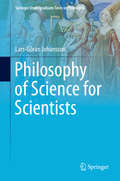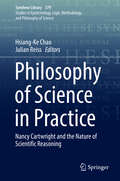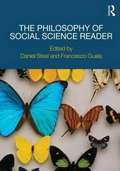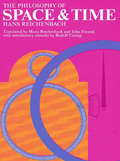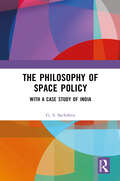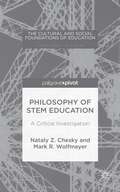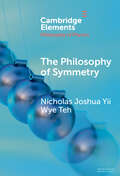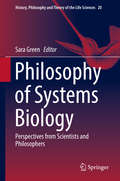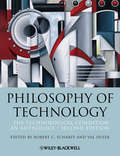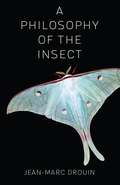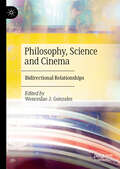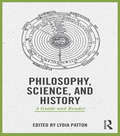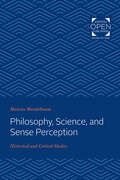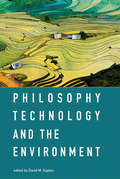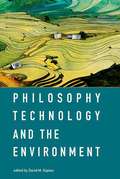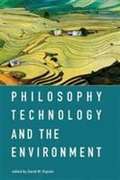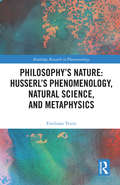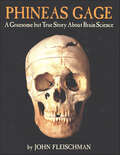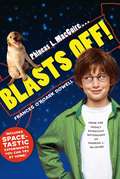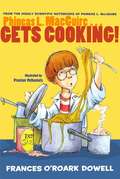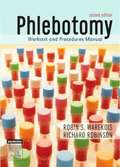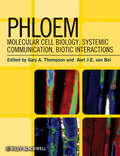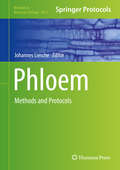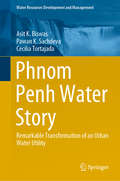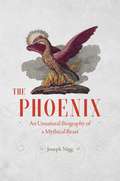- Table View
- List View
Philosophy of Science for Scientists
by Lars-Göran JohanssonThis textbook offers an introduction to the philosophy of science. It helps undergraduate students from the natural, the human and social sciences to gain an understanding of what science is, how it has developed, what its core traits are, how to distinguish between science and pseudo-science and to discover what a scientific attitude is. It argues against the common assumption that there is fundamental difference between natural and human science, with natural science being concerned with testing hypotheses and discovering natural laws, and the aim of human and some social sciences being to understand the meanings of individual and social group actions. Instead examines the similarities between the sciences and shows how the testing of hypotheses and doing interpretation/hermeneutics are similar activities. The book makes clear that lessons from natural scientists are relevant to students and scholars within the social and human sciences, and vice versa. It teaches its readers how to effectively demarcate between science and pseudo-science and sets criteria for true scientific thinking. Divided into three parts, the book first examines the question What is Science? It describes the evolution of science, defines knowledge, and explains the use of and need for hypotheses and hypothesis testing. The second half of part I deals with scientific data and observation, qualitative data and methods, and ends with a discussion of theories on the development of science. Part II offers philosophical reflections on four of the most important concepts in science: causes, explanations, laws and models. Part III presents discussions on philosophy of mind, the relation between mind and body, value-free and value-related science, and reflections on actual trends in science.
Philosophy of Science in Practice
by Hsiang-Ke Chao Julian ReissThis volume reflects the 'philosophy of science in practice' approach and takes a fresh look at traditional philosophical problems in the context of natural, social, and health research. Inspired by the work of Nancy Cartwright that shows how the practices and apparatuses of science help us to understand science and to build theories in the philosophy of science, this volume critically examines the philosophical concepts of evidence, laws, causation, and models and their roles in the process of scientific reasoning. Each chapter is an important one in the philosophy of science, while the volume as a whole deals with these philosophical concepts in a unified way in the context of actual scientific practice. This volume thus aims to contribute to this new direction in the philosophy of science.
The Philosophy of Social Science Reader
by Francesco Guala Daniel SteelThe Philosophy of Social Science Reader is an outstanding, comprehensive and up-to-date collection of key readings in the philosophy of social science, covering the essential issues, problems and debates in this important interdisciplinary area. Each section is carefully introduced by the editors, and the readings placed in context. The anthology is organized into seven clear parts: Values and Social Science Causal Inference and Explanation Interpretation Rationality and Choice Individualism Norms Cultural Evolution. Featuring the work of influential philosophers and social scientists such as Ernest Nagel, Ian Hacking, John Searle, Clifford Geertz, Daniel Kahneman, Steven Lukes and Richard Dawkins, The Philosophy of Social Science Reader is the ideal text for philosophy of social science courses, and for students in related disciplines interested in the differences between the social and natural sciences.
The Philosophy of Space and Time
by Hans ReichenbachAn important landmark in the development of the empiricist conception of geometry, this book is still one of the clearest and most valuable expositions of the crisis in physical science and mathematics occasioned by the advent of the non-Euclidean geometries. With unusual depth and clarity, it covers the problem of the foundations of geometry, the theory of time, the theory and consequences of Einstein's relativity including: relations between theory and observations, coordinate definitions, relations between topological and metrical properties of space, the psychological problem of the possibility of a visual intuition of non-Euclidean structures, and many other important topics in modern science and philosophy.While some of the book utilizes mathematics of a somewhat advanced nature, the exposition is so careful and complete that most people familiar with the philosophy of science or some intermediate mathematics will understand the majority of the ideas and problems discussed.Partial CONTENTS: I. The Problem of Physical Geometry. Universal and Differential Forces. Visualization of Geometries. Spaces with non-Euclidean Topological Properties. Geometry as a Theory of Relations. II. The Difference between Space and Time. Simultaneity. Time Order. Unreal Sequences. Ill. The Problem of a Combined Theory of Space and Time. Construction of the Space-Time Metric. Lorentz and Einstein Contractions. Addition Theorem of Velocities. Principle of Equivalence. Einstein's Concept of the Problems of Rotation and Gravitation. Gravitation and Geometry. Riemannian Spaces. The Singular Nature of Time. Spatial Dimensions. Reality of Space and Time.
The Philosophy of Space Policy: With a Case Study of India
by G. S. SachdevaSpace activities by governmental agencies require considerable state funding and bear long gestation periods with uncertainty in results. This necessitates the development of a directional policy defining long-term goals, embodying national aspirations, and envisaging techno-possibilities for manufacturing and operations. This book offers hints for such policy-making and also explores other alternatives to enable clarity for internal constituency and international posturingThe first section of this work discusses philosophical perspectives, namely – theoretical, theological, ethical and auditorial. The second section offers options and initiatives as alternatives or adjuncts to space policy. The subject matter in this book also includes a case study of India. It narrates a brief history of national space activities and the journey of Indian Space Research Organisation (ISRO), besides providing a futuristic vision for India and its global stance.Print edition not for sale in South Asia (India, Sri Lanka, Nepal, Bangladesh, Pakistan and Bhutan)
Philosophy of STEM Education: A Critical Investigation
by Nataly Z. Chesky Mark R. WolfmeyerFramed as educational equality initiatives that will help students gain the knowledge they need to compete in the global marketplace, STEM may be the most indicative educational reform discourse of our time and has grown to become one of the primary foci of educational policy, in part due to association with a wide array of today's industries: from information and communications technology to the medical field, to sustainability innovations. This book's primary focus is to shift the attention away from such utilitarian aims and ask critical questions about what aims the STEM initiatives are asking for and what assumptions do they hold about both teaching STEM and the nature of STEM content. In order to answer the above questions, the authors use a philosophical lens to study STEM policies as a political and social phenomenon.
The Philosophy of Symmetry (Elements in the Philosophy of Physics)
by Nicholas Joshua Yii Wye TehThis Element is a concise, high-level introduction to the philosophy of physical symmetry. It begins with the notion of 'physical representation' (the kind of empirical representation of nature that we effect in doing physics), and then lays out the historically and conceptually central case of physical symmetry that frequently falls under the rubric of 'the Relativity Principle,' or 'Galileo's Ship.' This material is then used as a point of departure to explore the key hermeneutic challenge concerning physical symmetry in the past century, namely understanding the physical significance of the notion of 'local' gauge symmetry. The approach taken stresses both the continuity with historically important themes such as the Relativity Principle, as well as novel insights earned by working with contemporary representational media such as the covariant phase space formalism.
Philosophy of Systems Biology
by Sara GreenThe emergence of systems biology raises many fascinating questions: What does it mean to take a systems approach to problems in biology? To what extent is the use of mathematical and computational modelling changing the life sciences? How does the availability of big data influence research practices? What are the major challenges for biomedical research in the years to come? This book addresses such questions of relevance not only to philosophers and biologists but also to readers interested in the broader implications of systems biology for science and society. The book features reflections and original work by experts from across the disciplines including systems biologists, philosophers, and interdisciplinary scholars investigating the social and educational aspects of systems biology. In response to the same set of questions, the experts develop and defend their personal perspectives on the distinctive character of systems biology and the challenges that lie ahead. Readers are invited to engage with different views on the questions addressed, and may explore numerous themes relating to the philosophy of systems biology. This edited work will appeal to scholars and all levels, from undergraduates to researchers, and to those interested in a variety of scholarly approaches such as systems biology, mathematical and computational modelling, cell and molecular biology, genomics, systems theory, and of course, philosophy of biology.
Philosophy of Technology: The Technological Condition: An Anthology (Blackwell Philosophy Anthologies #3)
by Robert C. ScharffThe new edition of this authoritative introduction to the philosophy of technology includes recent developments in the subject, while retaining the range and depth of its selection of seminal contributions and its much-admired editorial commentary. Remains the most comprehensive anthology on the philosophy of technology available Includes editors’ insightful section introductions and critical summaries for each selection Revised and updated to reflect the latest developments in the field Combines difficult to find seminal essays with a judicious selection of contemporary material Examines the relationship between technology and the understanding of the nature of science that underlies technology studies
A Philosophy of the Insect
by Jean-Marc DrouinThe world of insects is at once beneath our feet and unfathomably alien. Small and innumerable, insects surround and disrupt us even as we scarcely pay them any mind. Insects confront us with the limits of what is imaginable, while at the same time being essential to the everyday functioning of all terrestrial ecosystems.In this book, the philosopher and historian of science Jean-Marc Drouin contends that insects pose a fundamental challenge to philosophy. Exploring the questions of what insects are and what scientific, aesthetic, ethical, and historical relationships they have with humanity, he argues that they force us to reconsider our ideas of the animal and the social. He traces the role that insects have played in language, mythology, literature, entomology, sociobiology, and taxonomy over the centuries. Drouin emphasizes the links between humanistic and scientific approaches—how we have projected human roles onto insects and seen ourselves in insect form. Caught between the animal and plant kingdoms, insects force us to confront and reevaluate our notions of gender, family, society, struggle, the division of labor, social organization, and individual and collective intelligence. A remarkably original and thought-provoking work, A Philosophy of the Insect is an important book for animal studies, environmental ethics, and the history and philosophy of science.
Philosophy, Science and Cinema: Bidirectional Relationships
by Wenceslao J. GonzalezNow that cinema is offline and online, the capacity of cinema to relate to philosophy and science has increased. In this regard, this book seeks to deepen the relationship between philosophy, science, and cinema in terms of bilaterality. This analysis leads to several successive levels of analysis. First, between philosophy and cinema, where the philosophical perspective bifurcates in several directions, depending on the philosophical branch used. This affects in both directions: from the philosophical orientation to the cinematographic activity and, from cinema, towards the philosophical line used. Second, the relations between science and cinema also go in both directions. Thus, they are modulated by the type of scientific research used and by the film genre employed. Thus, bilaterality is altogether a network of bidirectional relations modulated by various possibilities of analysis.
Philosophy, Science, and History: A Guide and Reader
by Lydia PattonPhilosophy, Science, and History: A Guide and Reader is a compact overview of the history and philosophy of science that aims to introduce students to the groundwork of the field, and to stimulate innovative research. The general introduction focuses on scientific theory change, assessment, discovery, and pursuit. Part I of the Reader begins with classic texts in the history of logical empiricism, including Reichenbach’s discovery-justification distinction. With careful reference to Kuhn’s analysis of scientific revolutions, the section provides key texts analyzing the relationship of HOPOS to the history of science, including texts by Santayana, Rudwick, and Shapin and Schaffer. Part II provides texts illuminating central debates in the history of science and its philosophy. These include the history of natural philosophy (Descartes, Newton, Leibniz, Kant, Hume, and du Châtelet in a new translation); induction and the logic of discovery (including the Mill-Whewell debate, Duhem, and Hanson); and catastrophism versus uniformitarianism in natural history (Playfair on Hutton and Lyell; de Buffon, Cuvier, and Darwin). The editor’s introductions to each section provide a broader perspective informed by contemporary research in each area, including related topics. Each introduction furnishes proposals, including thematic bibliographies, for innovative research questions and projects in the classroom and in the field.
Philosophy, Science, and Sense Perception: Historical and Critical Studies
by Maurice MandelbaumOriginally published in 1964. In four essays, Professor Mandelbaum challenges some of the most common assumptions of contemporary epistemology. Through historical analyses and critical argument, he attempts to show that one cannot successfully sever the connections between philosophic and scientific accounts of sense perception. While each essay is independent of the others, and the argument of each must therefore be judged on its own merits, one theme is common to all: that critical realism, as Mandelbaum calls it, is a viable epistemological position, even though some schools of thought hold it in low esteem.
Philosophy, Technology, and the Environment (The\mit Press Ser.)
by David KaplanContributions by prominent scholars examining the intersections of environmental philosophy and philosophy of technology.Environmental philosophy and philosophy of technology have taken divergent paths despite their common interest in examining human modification of the natural world. Yet philosophers from each field have a lot to contribute to the other. Environmental issues inevitably involve technologies, and technologies inevitably have environmental impacts. In this book, prominent scholars from both fields illuminate the intersections of environmental philosophy and philosophy of technology, offering the beginnings of a rich new hybrid discourse. All the contributors share the intuition that technology and the environment overlap in ways that are relevant in both philosophical and practical terms. They consider such issues as the limits of technological interventions in the natural world, whether a concern for the environment can be designed into things, how consumerism relates us to artifacts and environments, and how food and animal agriculture raise questions about both culture and nature. They discuss, among other topics, the pessimism and dystopianism shared by environmentalists, environmental philosophers, and philosophers of technology; the ethics of geoengineering and climate change; the biological analogy at the heart of industrial ecology; green products and sustainable design; and agriculture as a bridge between technology and the environment.ContributorsBraden Allenby, Raymond Anthony, Philip Brey, J. Baird Callicott, Brett Clark, Wyatt Galusky, Ryan Gunderson, Benjamin Hale, Clare Heyward, Don Idhe, Mark Sagoff, Julian Savulescu, Paul B. Thompson, Ibo van de Poel, Zhang Wei, Kyle Powys Whyte
Philosophy, Technology, and the Environment
by David M. KaplanEnvironmental philosophy and philosophy of technology have taken divergent paths despite their common interest in examining human modification of the natural world. Yet philosophers from each field have a lot to contribute to the other. Environmental issues inevitably involve technologies, and technologies inevitably have environmental impacts. In this book, prominent scholars from both fields illuminate the intersections of environmental philosophy and philosophy of technology, offering the beginnings of a rich new hybrid discourse. All the contributors share the intuition that technology and the environment overlap in ways that are relevant in both philosophical and practical terms. They consider such issues as the limits of technological interventions in the natural world, whether a concern for the environment can be designed into things, how consumerism relates us to artifacts and environments, and how food and animal agriculture raise questions about both culture and nature. They discuss, among other topics, the pessimism and dystopianism shared by environmentalists, environmental philosophers, and philosophers of technology; the ethics of geoengineering and climate change; the biological analogy at the heart of industrial ecology; green products and sustainable design; and agriculture as a bridge between technology and the environment.ContributorsBraden Allenby, Raymond Anthony, Philip Brey, J. Baird Callicott, Brett Clark, Wyatt Galusky, Ryan Gunderson, Benjamin Hale, Clare Heyward,Don Idhe, Mark Sagoff, Julian Savulescu, Paul B. Thompson, Ibo van de Poel, Zhang Wei,Kyle Powys Whyte
Philosophy, Technology, and the Environment
by David M. KaplanEnvironmental philosophy and philosophy of technology have taken divergent paths despite their common interest in examining human modification of the natural world. Yet philosophers from each field have a lot to contribute to the other. Environmental issues inevitably involve technologies, and technologies inevitably have environmental impacts. In this book, prominent scholars from both fields illuminate the intersections of environmental philosophy and philosophy of technology, offering the beginnings of a rich new hybrid discourse. All the contributors share the intuition that technology and the environment overlap in ways that are relevant in both philosophical and practical terms. They consider such issues as the limits of technological interventions in the natural world, whether a concern for the environment can be designed into things, how consumerism relates us to artifacts and environments, and how food and animal agriculture raise questions about both culture and nature. They discuss, among other topics, the pessimism and dystopianism shared by environmentalists, environmental philosophers, and philosophers of technology; the ethics of geoengineering and climate change; the biological analogy at the heart of industrial ecology; green products and sustainable design; and agriculture as a bridge between technology and the environment.ContributorsBraden Allenby, Raymond Anthony, Philip Brey, J. Baird Callicott, Brett Clark, Wyatt Galusky, Ryan Gunderson, Benjamin Hale, Clare Heyward,Don Idhe, Mark Sagoff, Julian Savulescu, Paul B. Thompson, Ibo van de Poel, Zhang Wei,Kyle Powys Whyte
Philosophy's Nature: Husserl's Phenomenology, Natural Science, and Metaphysics (Routledge Research in Phenomenology)
by Emiliano TrizioThis book offers a systematic interpretation of the relation between natural science and metaphysics in Husserl’s phenomenology. It shows that Husserl’s account of scientific knowledge is a radical alternative to established methods and frameworks in contemporary philosophy of science. The author’s interpretation of Husserl’s philosophy offers a critical reconstruction of the historical context from which his phenomenological approach developed, as well as new interpretations of key Husserlian concepts such as metaphysics, idealization, life-world, objectivism, crisis of the sciences, and historicity. The development of Husserl’s philosophical project is marked by the tension between natural science and transcendental phenomenology. While natural science provides a paradigmatic case of the way in which transcendental phenomenology, ontology, empirical science, and metaphysics can be articulated, it has also been the object of philosophical misunderstandings that have determined the current cultural and philosophical crisis. This book demonstrates the ways in which Husserl shows that our conceptions of philosophy and of nature are inseparable. Philosophy’s Nature will appeal to scholars and advanced students who are interested in Husserl and the relations between phenomenology, natural science, and metaphysics.
Phineas Gage: A Gruesome but True Story About Brain Science
by John FleischmanPhineas Gage was truly a man with a hole in his head. Phineas, a railroad construction foreman, was blasting rock near Cavendish, Vermont, in 1848 when a thirteen-pound iron rod was shot through his brain. Miraculously, he survived to live another eleven years and become a textbook case in brain science.At the time, Phineas Gage seemed to completely recover from his accident. He could walk, talk, work, and travel, but he was changed. Gage "was no longer Gage," said his Vermont doctor, meaning that the old Phineas was dependable and well liked, and the new Phineas was crude and unpredictable.His case astonished doctors in his day and still fascinates doctors today. What happened and what didn&’t happen inside the brain of Phineas Gage will tell you a lot about how your brain works and how you act human.
Phineas L. MacGuire . . . Blasts Off!
by Frances O'Roark Dowell Preston McdanielsHouston,we have a problem! Phineas L. MacGuire (a.k.a. Mac) is less than up-to-date on planetary happenings. (Marsquakes? Who knew?) If he's going to be the best scientist in the fourth grade, Mac has to set his sights pretty high. To outer space, actually. But Space Camp is expensive. Where is he going to find enough money for a week on Mars (or a pretty close simulation thereof)? Houston, we have another problem: a gigantic, slobbery dog named Lemon Drop. Mac can earn the money he needs by walking Mrs. McClosky's yellow Lab, but first he needs to survive the walks and the slobber! Good thing Mac is a scientific genius with friends like Ben and Aretha. Together the three of them discover that Lemon Drop is no ordinary dog -- that Lab is a real-life Lab-oratory.
Phineas L. MacGuire . . . Gets Cooking!
by Frances O'Roark Dowell Preston McdanielsChemistry in the kitchen? Phineas L. MacGuire applies his science skills to culinary creations in this food-tastic tale from the bestselling author of Chicken Boy.Phineas L. MacGuire--scientist extraordinaire--has a new chore: cooking dinner every night. He may be a genius, but he knows nothing about following a recipe. A pinch? A dash? A smidge? This doesn't seem very scientific. A pound of spaghetti? Salt on brownies? Lemon in biscuits? Why, these recipes look a little funky. But he'd better learn quickly if he and his friends are going to win the $10,000 Bake-Off prize. And to complicate matters, school bully Evan Forbes has taken a liking to Phineas's brownies...too much of a liking. As in, if Phineas can't make Evan enough brownies, he'll get clobbered for sure. Fortunately for Phineas, he has the help of his friends, and even better, he soon discovers that cooking is kind of like chemistry. So the whole recipe thing might just work out--as long as he can keep his cool in the kitchen.
Phlebotomy Worktext and Procedure Manual (Second Edition)
by Richard Robinson Robin S. WarekoisThe book provides a complete introduction to the practice of phlebotomy in all its aspects.
Phloem
by Aart J.E. van Bel Gary A. ThompsonPhloem: Molecular Cell Biology, Systemic Communication, Biotic Interactions is a timely collection of research on the cellular and molecular biology of this plant vascular tissue. Recent advances in phloem research have revealed the centrality of this plant tissue to whole plant development and physiology. Building on advances made through developments of new analytical technologies, this book will provide readers with a current and comprehensive reference on the role of phloem in plant growth and development. Collecting the work of a global team of leading researchers, Phloem will provide the reader with a valuable synthesis of the latest research in a single volume.
Phloem: Methods and Protocols (Methods in Molecular Biology #2014)
by Johannes LiescheThis detailed book presents methods that enable the determination of parameters relevant to phloem research in the most efficient ways, putting plant scientists with access to adequate instrumentation in the position to answer any phloem-related question. The collection explores techniques that have been used for decades, such as tracing phloem transport with carbon isotopes, as well as recent developments, such as esculin-based assays of phloem transport and super-resolution microscopy of phloem proteins. As such, the book presents the state-of-the-art in phloem research and, at the same time, a starting point for the development of new methods that will fill the remaining gaps in the phloem researcher’s toolbox in the future. Written for the highly successful Methods in Molecular Biology series, chapters include introductions to their respective topics, lists of the necessary materials and reagents, step-by-step, readily reproducible protocols, and tips on troubleshooting and avoiding known pitfalls. Authoritative and comprehensive, Phloem: Methods and Protocols is an ideal guide for all researchers exploring this challenging area of plant biology.
Phnom Penh Water Story: Remarkable Transformation of an Urban Water Utility (Water Resources Development and Management)
by Asit K. Biswas Pawan K. Sachdeva Cecilia TortajadaThis book analyses how a water utility from a developing country, Phnom Penh Water Supply Authority, that was totally dysfunctional, corruption-ridden and literally bankrupt in 1993, became one of the most successful water utilities of the developing world in only about 15 years. By 2010, some of the performance indicators of this public sector utility were even better than London, Paris or Los Angeles. The book further analyses the enabling conditions that made this remarkable transformation possible. Based on this analysis, a framework is recommended for water utilities from developing countries so that they can also be transformed into functional, efficient, equitable and financially viable institutions on a sustainable basis.
The Phoenix: An Unnatural Biography of a Mythical Beast
by Joseph NiggArising triumphantly from the ashes of its predecessor, the phoenix has been an enduring symbol of resilience and renewal for thousands of years. But how did this mythical bird become so famous that it has played a part in cultures around the world and throughout human history? How much of its story do we actually know? Here to offer a comprehensive biography and engaging (un)natural history of the phoenix is Joseph Nigg, esteemed expert on mythical creatures--from griffins and dragons to sea monsters. Beginning in ancient Egypt and traveling around the globe and through the centuries, Nigg's vast and sweeping narrative takes readers on a brilliant tour of the cross-cultural lore of this famous, yet little-known, immortal bird. Seeking both the similarities and the differences in the phoenix's many myths and representations, Nigg describes its countless permutations over millennia, including legends of the Chinese "phoenix," which was considered one of the sacred creatures that presided over China's destiny; classical Greece and Rome, where it can be found in the writings of Herodotus and Ovid; nascent and medieval Christianity, in which it came to embody the resurrection; and in Europe during the Renaissance, when it was a popular emblem of royals. Nigg examines the various phoenix traditions, the beliefs and tales associated with them, their symbolic and metaphoric use, the skepticism and speculation they've raised, and their appearance in religion, bestiaries, and even contemporary popular culture, in which the ageless bird of renewal is employed as a mascot and logo, including for our own University of Chicago. Never bested by hardship or defeated by death, the phoenix is the ultimate icon of hope and rebirth. And in The Phoenix: An Unnatural Biography of a Mythical Beast, it finally has its due--a complete chronicle worthy of such a fantastic and phantasmal creature. This entertaining and informative look at the life and transformation of the phoenix will be the authoritative source for anyone fascinated by folklore and mythology, re-igniting our curiosity about one of myth's greatest beasts.
